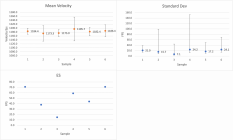Some concepts to consider, to help explain why you don’t see the data being asked for in this discussion.
Let’s call one the average trend line of the velocity versus powder charge, and the other one the whisker plot or box plot of the velocity along that velocity trend line. Both for a fixed case volume and seating depth, just to make the concepts simple. (When the variables of powder selections, bullet designs, primers, case volumes, seating depths, reamers, and others, are added to the discussion, you will begin to understand where this is going...)
If we just plot an average line (or single sweep line), we see non linear behavior superimposed on a sloped line of increasing velocity with charge. We call it a flat spot if the velocity plot inflects or bends down away from that common slope. For a flat spot to be useful, it would be several steps wide. Let’s say for arguments sake it is about three fourths to a full grain wide, since some folks test with tiny steps and others jump with big strides.
However, as has already been pointed out, we don’t want to kid ourselves into thinking a single sweep line, or an average line tells us the story, so we also want that box plot graph. That box plot is the one that shows us if the flat spot is also where there is a small ES or a large one, because they don’t always have to occur together.
The reason many will say that “the next time I tried to repeat that performance” and they didn’t, is that while an average trendline may show the flat spot, it will be a statistical chance that the node they were chasing sits on a narrow spot or wide spot on the box plot. A flat spot might be in a statistically noisy range where the internal ballistics and the barrel harmonics don’t line up for us.
Gas harmonics are easy to understand when the concepts are simple. Gas can resonate like any other spring, mass, damping system. If they didn’t, we would not have wind instruments. Understanding why adiabatic combustion can have a resonance or dispersion, is a much more difficult explanation for another day.
If we only cared about velocity, it would only be a matter of using a chronograph and enough samples, however, that doesn’t make us happy when we also look at precision and accuracy. Some thermodynamic resonances have harmonic behavior as the powder charge increases, but some of them are noisy. When those combine with the structural harmonics of the barrel and supports, we start to see the whole system. Hitting state of the art performance happens when those mechanical and combustion harmonics “tune” to our advantage. Finding them and getting some sort of predictable control over them is part of what this whole forum is about. But most of us don’t have a corporate or Pentagon sized budget to spend finding these nodes, not to mention fully characterizing the barrel at speeds we don’t intend to use.











